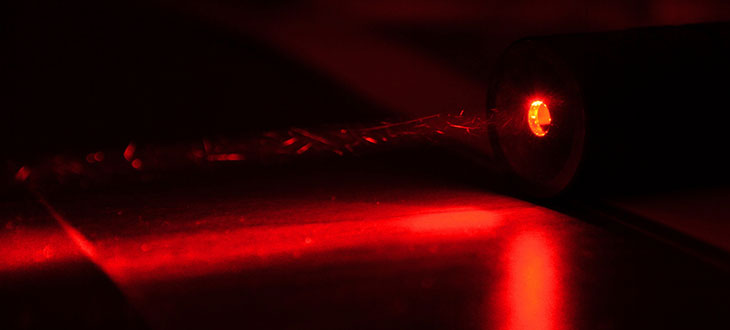Physicists Create "Air Laser" In Laboratory

(Inside Science) -- A laser could be created with air in a practical way, a new advance that could one day be used to help spot explosives or pollutants from afar, researchers say.
Laser light is generated by pumping energy into atoms or other objects. A chain reaction can occur in which energized atoms all stimulate each other to give off laser light.
One way laser light differs from normal light is that all the light waves in a laser beam are the same frequency — that is, color. Another difference is that all the light waves in a laser beam are coherent — the peaks and troughs of these light waves overlap exactly. These properties help laser beams focus on tight spots and stay narrow for long distances.
The material that gets stimulated to generate laser light can be exotic in nature, such as ruby or sapphire. However, in principle, even air can serve as a laser — a normal laser fired into the atmosphere, dubbed a pump laser, could potentially stimulate air it passed through enough to make that very air act like a laser in return.
Getting air to behave like a laser could have a wide variety of applications. The frequencies of light given off by such air lasers would yield insights on molecules in the air, and the capability to analyze the chemical composition of air could be invaluable for detecting traces of explosives for airport or military security, or identifying pollutants for environmental studies.
It "potentially opens up new ways to detect things in the air at long distance," said researcher Pavel Polynkin, a laser physicist at the University of Arizona in Tucson.
However, despite years of research, scientists had not discovered a way to generate air lasers intense enough for practical use. Previous attempts mostly tried using pump lasers to excite air enough to generate filaments of plasma -- electrically charged gases -- that in turn would serve as lasers. However, these air lasers are rather weak, requiring highly sensitive detectors to spot their light.
"Remote air lasing has been discussed for at least 10 years," said physicist Günter Steinmeyer at the Max Born Institute for Nonlinear Optics and Short Pulse Spectroscopy in Berlin, who did not take part in this research. "Several people claimed to have demonstrated it before, but these demonstrations were never fully convincing."
Now Polynkin and his colleagues have developed a new technique that could allow practical air lasers. This strategy is up to 200 times more efficient than previous methods when it comes to creating air lasers from atmospheric components such as nitrogen.
"That was unexpected and very exciting," Polynkin said.
The new strategy involves two lasers of different colors. First, an infrared laser pulse breaks apart the nitrogen and oxygen molecules in the air into their constituent atoms. Next, an ultraviolet laser pulse can excite either the nitrogen or oxygen atoms, depending on which frequency of ultraviolet light is chosen, making the atoms give off near-infrared light like a laser.
"The air laser is in the form of a single beam which traces the path of the original laser, but goes backwards, towards the observer," Polynkin said.
So far the researchers have only tested their technique in the confines of a lab. Still, in theory, they suggest their strategy could generate air lasers "at a large distance from the ground — hundreds of meters," Polynkin said.
It remains uncertain whether or not this new strategy can generate air lasers at greater distances, which are needed in order to scan the upper atmosphere.
"The pumping wavelengths that we use are quite difficult to generate, and they don't propagate far in the atmosphere," Polynkin said. "The propagation range is limited to a few hundred meters to a kilometer."
To extend this strategy to more remote distances, "it may be interesting to try other wavelengths," Steinmeyer said. "The combination used by the authors may not be ideal yet."
Polynkin and his colleagues Alexandre Laurain and Maik Scheller detailed their findings online in December in the journal Physical Review Letters.

